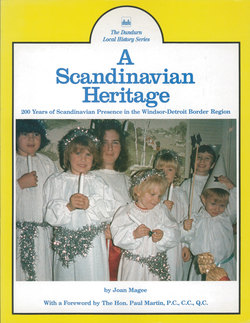Читать книгу A Scandinavian Heritage - Joan Magee - Страница 8
На сайте Литреса книга снята с продажи.
ОглавлениеPreface
In his preface to A Dutch Heritage: 200 Years of Dutch Presence in The Windsor-Detroit Border Region, R. Allan Douglas, Curator of the Hiram Walker Historical Museum of Windsor wrote:
Those who see only the Indians - whatever that vague term means - succeeded by the French and then the British, do themselves a great disservice by overlooking the depth and the variety of the country’s ethnic landscape. It is true that the groups just mentioned have, by reason of the historical process, been largely responsible for the character of life in Essex County. Others, however, from the Albanians to the Zimbabweans, have contributed important variations.
Among those who have contributed to this ethnic landscape are those immigrants who come from the countries often grouped together under the general name of Scandinavia, a term which includes Norway, Sweden, and Denmark, and sometimes Finland and Iceland.
The five countries form a varied group. Three are monarchies — Norway, Sweden, and Denmark — while Finland and Iceland are republics. Except for a majority of the Finns, all of these Scandinavians are Nordics. All, with the exception of the majority of Finns, speak a related Nordic language. Only about 7 percent of the people of Finland speak Swedish (a Nordic language) rather than Finnish (a Finno-Ugric language) as their mother tongue. Yet both Swedish and Finnish are official languages in Finland, and many of the younger people are conversant with both having learned the second language in school. The majority of those who speak Swedish as their mother tongue live in the southwestern part of Finland where their ancestors settled in the middle ages.
The Census of Canada has reported the Scandinavian population in a variety of ways since 1871. At first, in 1871 and 1881, Danes, Icelanders, Norwegians, and Swedes were reported together as Scandinavians, while Finns were included with Russians. In the 1901 and 1911 Census reports Finns were reported separately. Since 1921 “Scandinavian” has been divided into Danish, Icelandic, Norwegian, and Swedish. Since 1901 Finnish has been reported separately, and has not been included when Danish, Icelandic, Norwegian, and Swedish are at times referred to collectively as “Scandinavian” in certain census reports. This variety in reporting methods is reflected in the census figures included as Appendices 2-10 of this book.
Within Scandinavia a newer collective name for these countries has gradually come into use during the past 50 years. This is “Norden”, translated as “The North”, and it includes all five of the countries mentioned. This book, A Scandinavian Heritage, sponsored by the Norden Society of Windsor, also includes all five countries in this wider definition. Immigrants from each of these five Northern nations will be considered in turn, in the order of their arrival over a period of 200 years, ultimately to form an integral part of Essex County’s ethnic landscape.
Joan Magee
A map of Scandinavia. The five countries Norway, Sweden, Denmark, Finland and Iceland are together popularly known to the outside world as Scandinavia. Within Scandinavia since the 1930s these five countries have come to call themselves collectively Norden (The North), in reference to the community which they have formed together.
